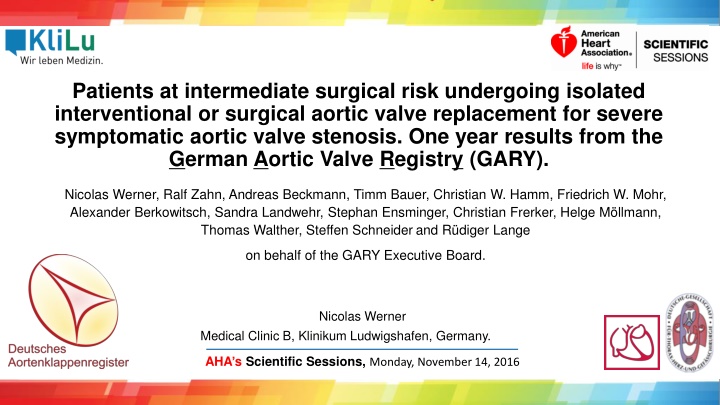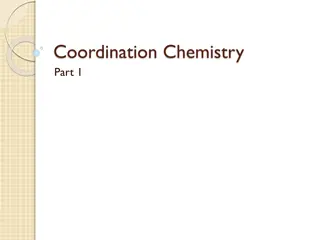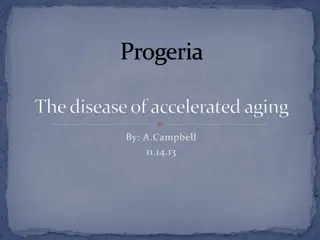
One-Year Results of Patients at Intermediate Surgical Risk Undergoing Aortic Valve Replacement - GARY Study
Explore the findings from the German Aortic Valve Registry (GARY) regarding patients at intermediate surgical risk undergoing aortic valve replacement for severe aortic valve stenosis. This study compares outcomes for patients receiving transcatheter aortic valve implantation (TAVI) versus surgical aortic valve replacement (SAVR) in real-world clinical practice. Discover insights on patient selection, safety, and efficacy of TAVI in this population.
Download Presentation

Please find below an Image/Link to download the presentation.
The content on the website is provided AS IS for your information and personal use only. It may not be sold, licensed, or shared on other websites without obtaining consent from the author. If you encounter any issues during the download, it is possible that the publisher has removed the file from their server.
You are allowed to download the files provided on this website for personal or commercial use, subject to the condition that they are used lawfully. All files are the property of their respective owners.
The content on the website is provided AS IS for your information and personal use only. It may not be sold, licensed, or shared on other websites without obtaining consent from the author.
E N D
Presentation Transcript
Patients at intermediate surgical risk undergoing isolated interventional or surgical aortic valve replacement for severe symptomatic aortic valve stenosis. One year results from the German Aortic Valve Registry (GARY). Nicolas Werner, Ralf Zahn, Andreas Beckmann, Timm Bauer, Christian W. Hamm, Friedrich W. Mohr, Alexander Berkowitsch, Sandra Landwehr, Stephan Ensminger, Christian Frerker, Helge M llmann, Thomas Walther, Steffen Schneider and R diger Lange on behalf of the GARY Executive Board. Nicolas Werner Medical Clinic B, Klinikum Ludwigshafen, Germany. AHA s Scientific Sessions, Monday, November 14, 2016
Declaration of interest Nicolas Werner has no conflict of interest
Background Transcatheter aortic valve implantation (TAVI) is currently the recommended treatment option for patients with severe aortic valve stenosis, who are inoperable or at high surgical risk. PARTNER II has proven TAVI to be non-inferior compared to SAVR in terms of mid-term mortality and disabling stroke in a selected population of patients at intermediate surgical risk (STS Score 4-8%). However, RCTs usually cover selected populations and their results do not reflect a real world situation. Large clinical registries, like GARY, are important additional tools to gain information on the use, selection of patients, safety and efficacy of a treatment strategy, like TAVI, in a real world population today.
Objectives Purpose of the present study number of patients at intermediate surgical risk undergoing TAVI or SAVR in Germany today compare clinical characteristics and outcome of an all-comers clinical population at intermediate surgical risk undergoing isolated TAVI or SAVR for severe aortic valve stenosis in clinical practice today German Aortic Valve Registry (GARY) Supported by: German Cardiac Society (DGK), German Society for Thoracic and Cardiovascular Surgery, German Heart Foundation. Design: - prospective and multicenter registry - follow-up at 30d, 1-, 3- and 5-years after index procedure - covering 87% of all aortic valve procedures performed in Germany from 2011-2013 Inclusion: all consecutive patients undergoing an invasive aortic valve therapy for acquired aortic valve disease ( all-comers-design ) Exclusion: missing informed consent
Methods / Statistics 49.660 patients enrolled into GARY from Jan. 2011 until Dec. 2013 were screened 22.7% (n=11.286/49.660) intermediate surgical risk / Log. EuroSCORE I 10-20% Log. EuroSCORE I: widespread use in Europe; recommended by ESC-guidelines 46.6% treated by TAVI (n=5.257/11.286), 53.4% treated by SAVR (n=6.029/11.286) After exclusion process: 5.997 patients with isolated TAVI or SAVR were included in the underlying analysis (represent 12% of total population) Univariate comparison between treatment groups Multivariable analysis on independent clinical predictors for TAVI Propensity Score analysis for adjusted comparison of one-year mortality of patients treated by TAVI vs. SAVR
Results I Baseline characteristics SAVR (n = 1896) 75.9 6.7 54.1% 13.4 2.7 3.7 2.1 28.2 4.8 72.4% 87.4% 31.5% 8.0% 54.5 13.8 21.7% 14.4% 20.6% 13.5% 5.8% 2.5% 10.4% TAVI (n = 4101) 81.8 5.4 61.6% 14.4 2.9 5.2 2.8 27.2 5.0 83.7% 88.4% 30.8% 10.5% 55.5 12.2 26.6% 10.0% 29.0% 26.0% 10.4% 4.0% 11.1% p-value < 0.001 < 0.001 < 0.001 < 0.001 < 0.001 < 0.001 0.282 0.602 0.003 0.094 0.008 < 0.001 < 0.001 < 0.001 < 0.001 0.004 0.431 Age Female Log. EuroSCORE I STS Score Body mass index (BMI) NYHA III IV Hypertension Diabetes mellitus Prior myocardial infarction Mean ejection fraction (%) Pulmonary hypertension Previous cardiac surgery Atrial fibrillation Mitral regurgitation 2 Permanent pacemaker Creatinine > 2 mg/dl Peripheral arterial vascular disease
Results II Indication and procedural characteristics TAVI (n = 4101) Indication for TAVI 77.2% - Age 47.3% - Frailty 24.9% - Requested by patient 0.8% - Malignoma 90.8% - Heart Team decision Procedural characteristics 75.0% TAVI with transfemoral access 25.0% TAVI with transapical access
Results Differences between sites Major differences in the amount of patients treated by TAVI at intermediate surgical risk between the 88 sites Range: 0 to 100%! Large site-depending effect
Independent predictors for TAVI Variable Wald p-value Odds ratio 95% CI 819.690 <0.001 1.23 (1.21-1.25) Age (per year) 102.702 <0.001 2.07 (1.79-2.38) Calcium Score Grade < 3 83.020 <0.001 2.11 (1.80-2.49) Prior cardiac decompensation 71.072 <0.001 2.00 (1.70-2.35) Coronary artery disease 58.940 <0.001 1.90 (1.61-2.24) Pulmonary hypertension 57.333 <0.001 1.83 (1.57-2.15) NYHA class III-IV 47.848 <0.001 2.22 (1.77-2.79) No previous CABG 30.994 <0.001 1.67 (1.39-2.00) Mitral valve regurgitation II-IV* 30.917 <0.001 1.95 (1.54-2.47) Tricuspid valve regurgitation II-III* 15.053 <0.001 1.50 (1.22-1.84) Prior PCI 14.849 <0.001 1.39 (1.17-1.64) No peripheral arterial disease 14.591 <0.001 1.63 (1.26-2.09) BMI < 22 (body mass index) 10.159 0.001 1.25 (1.09-1.44) Female gender
Results III Clinical outcome SAVR (n = 1896) TAVI (n = 4101) p-value In-hospital complications 1.2% / 1.3% 1.5% / 1.2% 0.281/ 0.816 Major / minor stroke 0.5% 0.3% 0.114 Myocardial infarction 5.3% New onset pacer / ICD 19.1% < 0.001 1.1% Vascular complications 7.7% < 0.001 0.4% 4.7% < 0.001 Aortic valve regurgitation grade II --- 1.0% --- Conversion to open heart surgery 25.0% 51.5% < 0.001 Bleeding 2 RBC units 1.3% Reintervention for bleeding 4.5% < 0.001 0.3% Pericardial tamponade 1.1% < 0.001 2.3% New onset dialysis (temporary) 3.6% 0.024
Results III Clinical outcome (all-cause mortality) % time p = 0.02 p = 0.01 p < 0.001
Unadjusted all-cause mortality (1-year FU) (Completeness of data: TAVI 97.5%; SAVR 98.9%)
Propensity Score analysis adjusted comparison of one-year mortality rate of patients treated by TAVI vs. SAVR PS calculated by using the logistic regression model Resulting PS estimators of the probability receiving TAVI One-year mortality rates were presented for propensity score quintiles
Propensity Score analysis All cause one-year mortality rates for SAVR and TAVI according to propensity score quintile SAVR vs. TAVI (transfemoral and transapical)
Propensity Score analysis All cause one-year mortality rates for SAVR and TAVI according to propensity score quintile SAVR vs. TAVI (transfemoral, only)
Limitations Risk of unmeasured confounding ( frailty only documented in TAVI-group in GARY) Risk stratification of a patient solely by using Log. EuroSCORE I All available risk scores are known to be inaccurate (especially in a TAVI population) Not possible to adjust for the Medical opinion of a Heart Team (also based on subjective factors of a patient s clinical condition) Major differences in the number of patients treated at intermediate surgical risk between the sites local aspects might have influenced the patient selection to TAVI or SAVR Clinical variables of inoperability (f.i. FEV1) of a patient not recorded in GARY (except porcelain aorta) some inoperable patients might have been included in the TAVI-group with a worse clinical outcome
Conclusion A relevant proportion of patients at intermediate surgical risk were treated with TAVI in Germany from 2011 until 2013. Patients undergoing TAVI significantly different with regard to age, gender and risk score marked selection bias in clinical reality (TAVI patients being at higher risk) Intermediate surgical risk patients undergoing isolated TAVI in a real-world scenario have a low in-hospital mortality rate (< 4%). Even after propensity score analysis a significant difference in one-year mortality rate persisted between SAVR and TAVI most probably caused by additional confounders. PARTNER II : non-inferiority of TAVI compared to SAVR in a selected intermediate-risk population. GARY: showed clinical reality and a reasonable selection of patients in everyday clinical practice.
Thank you for your attention! Thank you to all the participating sites in GARY!












